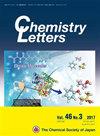Zirconium-based metal-organic framework with bis(hydroxyphenyl)anthracene derivative: molecular design, synthesis, crystal structures, and methane adsorption
IF 1.4
4区 化学
Q3 CHEMISTRY, MULTIDISCIPLINARY
引用次数: 0
Abstract
A metal-organic framework (MOF) composed of a zirconium cluster with a bis(hydroxyphenyl)anthracene linker, Zr6O4(OH)4(adhb)6 (adhb: 4,4′-(anthracene-9,10-diyl)bis(2-hydroxybenzoic acid), was designed to achieve methane storage up to 300 g and batch synthesized without using an autoclave. This MOF can adsorb 65.4 cm3STP/cm3 and 4.7w% of methane at 294 K and 9.8 bar due to its large specific surface area of 1,818 m2/g and void fraction of 0.78 cm3/g. Furthermore, an octahedral cage model indicated that the anthracene ring provides a suitable pore entrance and steric hindrance for methane inclusion.含有双(羟基苯基)蒽衍生物的锆基金属有机框架:分子设计、合成、晶体结构和甲烷吸附作用
研究人员设计了一种金属有机框架(MOF),该框架由锆簇和双(羟基苯基)蒽连接体 Zr6O4(OH)4(adhb)6(adhb:4,4′-(蒽-9,10-二基)双(2-羟基苯甲酸)组成,可使甲烷储存量达到 300 克,并且无需使用高压釜即可批量合成。这种 MOF 具有 1,818 m2/g 的大比表面积和 0.78 cm3/g 的空隙率,因此在 294 K 和 9.8 bar 条件下可吸附 65.4 cm3STP/cm3 和 4.7w% 的甲烷。此外,八面体笼模型表明,蒽环为甲烷的加入提供了合适的孔隙入口和立体阻碍。
本文章由计算机程序翻译,如有差异,请以英文原文为准。
求助全文
约1分钟内获得全文
求助全文
来源期刊

Chemistry Letters
化学-化学综合
CiteScore
3.00
自引率
6.20%
发文量
260
审稿时长
1.2 months
期刊介绍:
Chemistry Letters covers the following topics:
-Organic Chemistry-
Physical Chemistry-
Inorganic Chemistry-
Analytical Chemistry-
Materials Chemistry-
Polymer Chemistry-
Supramolecular Chemistry-
Organometallic Chemistry-
Coordination Chemistry-
Biomolecular Chemistry-
Natural Products and Medicinal Chemistry-
Electrochemistry
 求助内容:
求助内容: 应助结果提醒方式:
应助结果提醒方式:


